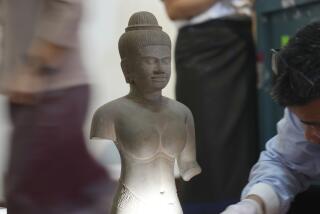Methodically Planned, Expertly Executed : Thieves in Nepal Plunder Prized Artifacts for Foreign Collectors
KATMANDU, Nepal — In the Katmandu valley, once a rich museum of art exhibited on hillsides, river banks and in groves, the gods now are chained and padlocked to protect them from plundering thieves and greedy foreign collectors.
Seventy percent of this Hindu Himalayan kingdom’s most prized artifacts have been stolen since 1951, when Nepal opened its doors to tourists, according to officials of Nepal Guthi Santhan, a religious trust in charge of temples and shrines.
Officials claim that the thefts are well-financed, methodically planned, expertly executed. Very few offenders have been caught while the artifacts wind up in museums, galleries and collectors’ homes abroad.
Chained and Locked
To safeguard the remaining treasures, temple priests and villagers are fettering their stone deities with massive iron chains and locks. Shrines are being surrounded by fences and high walls to keep away the nimble-fingered operators.
“As far as metal statues are concerned, there is hardly anything of value left in Nepal. They can only be seen in museums abroad,” said Amita Ray, a noted Indian scholar of Nepalese art, in Calcutta.
Many of the masterpieces in the Katmandu valley were created by the unsung, unknown craftsmen of the Newar community, the original inhabitants of the valley of gods. The Newaris are known for their culture, civilization and magnificence of their art and architecture.
Stiffer Sentences Urged
Among the treasures stolen were many idols from the 9th-Century Thakuri period and the Malla era between the 12th and 18th centuries, according to Lain Singh Bangdel, chancellor of the Royal Nepal Academy of Art and Literature.
Bangdel and other officials say the government should impose stiffer sentences to discourage these crimes. The maximum sentence for art theft is a five-year prison term or a fine of 25,000 rupees ($1,200) or both.
Two men currently are on trial on charges of stealing a 41-inch, gold-plated statue of Lord Buddha from a padlocked room by digging a tunnel from a neighboring house.
Mana Bahadur Tamang, one of the defendants, told police that neither he nor his companion knew how to dig a tunnel so “we employed an Indian to do the job and paid him 2,500 rupees ($120).”
Special Court Set Up
They are being tried by a special court set up to deal with art thefts. Since April, the court has heard six cases involving 21 people and sentenced them to terms ranging from six months to four years.
Statistics are not available on the number of thefts or sentences handed down since 1951.
Maya Devi Hyanju recalled that 600-year-old statues of Lakshmi, goddess of wealth, and Narayan, god of protection, were stolen from near her house in Bhaktapur, once of the ancient cities in the Katmandu valley. The Lakshmi statue is considered a masterpiece of stone sculpture because of its intricate carving.
“It was stolen on the night of a festival in March when the men were all drunk,” Hyanju, 65, said in an interview. “I heard the sound of cymbals and drums that accompanied the processions. Then I heard a minibus engine and the next morning the statue was gone.”
An ‘Inside Job’
Bishnu Prashad Khanal, chairman of the Nepal Guthi Santhan, said the theft was an “inside job and local residents were paid to keep quiet.” Priests and officials in temples, shrines and pagodas now maintain detailed lists of historical artifacts.
But investigations abroad are hampered by lack of photographs of statues.
“There is a general belief that gods should not be photographed because they are not objects of exhibition but reverence,” Khanal said.
Karna Sakya, general secretary of the Nepal Heritage Society, says poverty is a major factor behind the thefts. Someone who can lift a statue can earn thousands of dollars a year in Nepal where the per capita income is $160.
Other officials claim that lax security at Nepal airports, an inefficient bureaucracy and a corrupt police force are responsible for the smuggling.
“The bureaucracy is bungling, and affluent nations do not have laws that actually discourage the inflow of such cultural antiques,” Sakya said.
More to Read
Sign up for Essential California
The most important California stories and recommendations in your inbox every morning.
You may occasionally receive promotional content from the Los Angeles Times.










